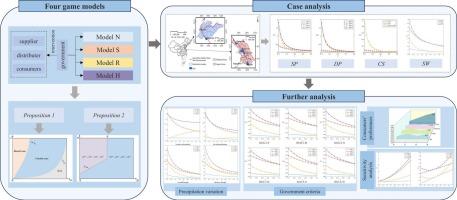调水供应链中政府干预下的综合水质改善与节水机制
IF 6.3
1区 地球科学
Q1 ENGINEERING, CIVIL
引用次数: 0
摘要
在调水工程中,改善水质、节约水量是水环境保护和水资源可持续利用的关键。调水工程既具有公益性,又具有利润驱动性,既受市场交易机制的影响,又受政府干预的影响。本研究构建了政府、供给者、分销者、消费者参与的调水供应链框架,通过改善水质和节约水量来提升社会福利。考虑到消费者对水质的偏好,采用Stackelberg博弈模型来捕捉基准和三种政府干预情景下利益相关者之间的决策互动。通过理论推导和实际案例分析,评价了三种干预措施的有效性。我们进一步研究了消费者偏好、沉淀和政府标准对社会福利的影响。结果表明,当水质改善成本系数低于0.556的阈值时,三种政府干预均能提高供应链利润和消费者剩余。此外,在动态环境条件下(即降水变化)或政府关注标准的变化,混合干预比单一的质量补贴或数量监管表现出更强的稳健性,始终产生最高的社会福利。需要注意的是,错误判断消费者对水质的偏好可能会导致巨大的社会福利损失,不同偏好情景下的社会福利偏差最大可达59.63%。研究结果可为政府在调水工程中提质节量、改善社会福利提供实践启示。本文章由计算机程序翻译,如有差异,请以英文原文为准。

An integrated water quality-improving and quantity-saving mechanism under government interventions in water diversion supply chain
Water quality-improving and quantity-saving are crucial for the water environmental protection and sustainable water resources utilization in water diversion projects. Water diversion projects, which possess both public benefit and profit-driven characteristics, are not only influenced by the market transaction mechanisms but also influenced by the government interventions. This study develops a water diversion supply chain framework involving the government, supplier, distributor, and consumers to enhance social welfare by integrating water quality-improving and quantity-saving. Considering consumers’ preferences for water quality, a Stackelberg game model is used to capture decision-making interactions among stakeholders under a benchmark and three government intervention scenarios. The effectiveness of three interventions is evaluated via theoretical derivation and real-case analysis. We further examine the impacts of consumer preferences, precipitation, and government criteria on social welfare. The results indicate that all three government interventions can enhance both supply chain’s profit and consumer surplus when the water quality-improving cost coefficient is below the threshold of 0.556. Further, under dynamic environmental conditions (i.e., precipitation variation) or changes in government concern criteria, hybrid intervention shows greater robustness compared to single quality subsidy or quantity regulation, consistently yielding the highest social welfare. Note that misjudging consumer preferences for water quality may lead to substantial social welfare losses, with the maximum deviation in social welfare under different preference scenarios reaching 59.63%. Our findings provide practical insights for government to improve quality and save quantity in the water diversion projects for social welfare improvement.
求助全文
通过发布文献求助,成功后即可免费获取论文全文。
去求助
来源期刊

Journal of Hydrology
地学-地球科学综合
CiteScore
11.00
自引率
12.50%
发文量
1309
审稿时长
7.5 months
期刊介绍:
The Journal of Hydrology publishes original research papers and comprehensive reviews in all the subfields of the hydrological sciences including water based management and policy issues that impact on economics and society. These comprise, but are not limited to the physical, chemical, biogeochemical, stochastic and systems aspects of surface and groundwater hydrology, hydrometeorology and hydrogeology. Relevant topics incorporating the insights and methodologies of disciplines such as climatology, water resource systems, hydraulics, agrohydrology, geomorphology, soil science, instrumentation and remote sensing, civil and environmental engineering are included. Social science perspectives on hydrological problems such as resource and ecological economics, environmental sociology, psychology and behavioural science, management and policy analysis are also invited. Multi-and interdisciplinary analyses of hydrological problems are within scope. The science published in the Journal of Hydrology is relevant to catchment scales rather than exclusively to a local scale or site.
 求助内容:
求助内容: 应助结果提醒方式:
应助结果提醒方式:


